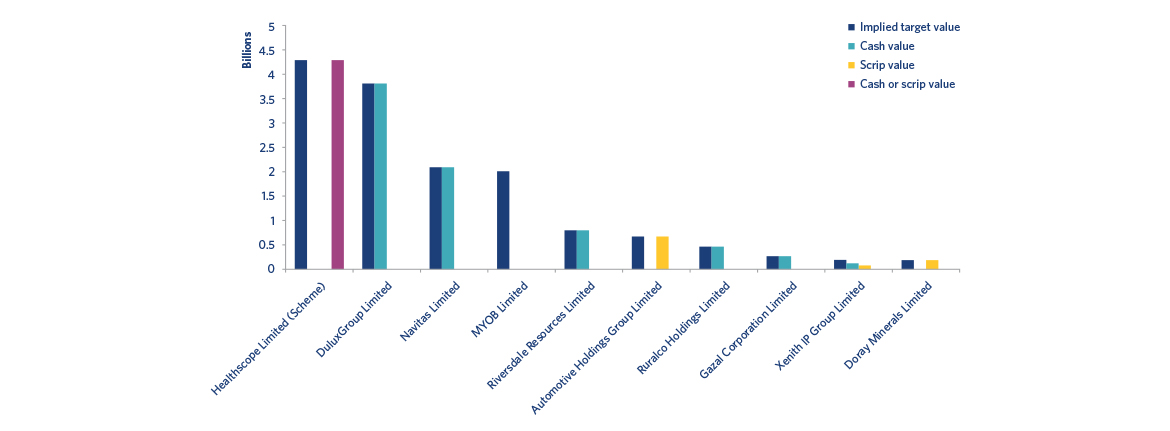We review and provide commentary on ASIC’s public M&A related activities over the first half of 2019 and the future areas of ASIC’s regulatory focus, as described in the corporate finance report published by ASIC in September.
In brief
|
ASIC’s corporate finance report
ASIC has released its biannual report summarising its corporate regulatory activity over the first half of 2019.1 This report contains key statistics and observations from ASIC’s regulatory oversight of transactions over the period, insights into areas of focus, and plans for policy updates.2
We provide some of the public M&A highlights below.
Overview of public M&A activity
Public M&A activity over the period was relatively low compared to activity in Australia previously: ASIC reported 29 control transactions over the first 6 months of 2019, which represented a decrease compared to the 44 control transactions that were reported over the last 6 months of 2018.
Some notable observations from the period include:
- Schemes vs bids: Consistent with prior periods, although the number of control transactions undertaken by way of takeover and scheme were similar, the larger transactions were undertaken by way of scheme and the majority of the transactions under A$50 million in value were undertaken by way of takeover. See Figure 1:

- Continued offshore interest in Australia: Offshore acquirers accounted for 73% by value and 48% by number of control transactions in the period, which is largely consistent with the statistics reported in the prior half year report. See Figure 2:

- Cash continues to be the preference for large control transactions: The largest control transactions were offers of all-cash consideration, with all-cash offers making up 6 of the top 10 offers, which has been a consistent theme over the past few years. See Figure 3:

Insights from ASIC’s activity and future areas of focus
Schemes of arrangement
The corporate finance report notes that over the period ASIC scrutinised control transactions that were undertaken via a scheme of arrangement, with a focus on ensuring fairness and equality in these transactions. Certain case studies where ASIC has intervened in this regard are summarised below.
Benefits and classes
In the Healthscope Limited scheme of arrangement, ASIC intervened to oppose the convening of the scheme on the basis that an interested party and its affiliates (the Group) should form a separate class and that a separate meeting of each class should be convened. In this matter, ASIC also refused to provide a no-objection letter for the scheme.
The Group acquired a strategic stake in Healthscope through the use of a forward derivative contract, with the intention of pursuing the acquisition of certain Healthscope assets via a scheme of arrangement. Brookfield Business Partners and its institutional partners (the scheme acquirer, Brookfield) and Healthscope subsequently entered into various interrelated agreements to sell assets to the Group in connection with the proposed scheme. The Group agreed to procure that the holders of shares underlying the forward derivative contract voted in favour of the scheme.
ASIC argued that the magnitude and nature of the arrangements positioned the Group similarly to a joint proponent of the deal — justifying a separate class under the traditional test. Healthscope resisted ASIC’s argument. However, consistent with usual practices in similar situations, Healthscope undertook to tag the votes of the Group so that the Court could consider the effect of any voting by the Group on the passing of the resolution to approve the Scheme, including whether those votes should be discounted. Given the votes demonstrated overwhelming support of the Scheme shareholders, the Court ultimately approved the scheme.
We have previously discussed this transaction as part of our Australian M&A podcast series.
Director benefits and recommendations
There has been a string of recent cases relating to the disclosure and consequences of ‘contingent benefits’ received by directors and director recommendations, including Re Gazal Corporation Limited [2019] FCA 701, Re Ruralco Holdings Limited [2019] FCA 878, Re Kidman Resources Limited [2019] FCA 1226, Re Navitas Ltd (No 2) [2019] WASC 218, Re Nzuri Copper Ltd [2019] WASC 189, and Re Villa World Limited [2019] NSWSC 1207.
ASIC’s view on this issue is that when a director will receive a contingent benefit in connection with a scheme:
- the benefit should be prominently disclosed, including in each place where the director’s recommendation is cited in the scheme booklet and in any other communications;
- the director should carefully consider whether the contingent benefit means it may be appropriate to refrain from making their recommendation or to explain their decision (taking into account all of the circumstances in which the director is making the recommendation under the scheme, not just the type or quantum of contingent benefit involved); and
- the perception of a potential conflict may be relevant when considering whether the director should chair the scheme meeting.
We have written further on this topic here.
Disclosures outside the scheme booklet
ASIC has noted that it will regularly monitor disclosures made outside the scheme booklet and will intervene if they do not meet the standard expected of disclosures inside the scheme booklet or warrant a supplementary dispatch.
In Netcomm Wireless Limited (No 2) [2019] FCA 1109, NetComm announced just a week before the scheme meeting that two proxy advisers had recommended that shareholders vote in favour of the scheme. ASIC was concerned that this announcement invited holders to simply rely on the conclusion of the proxy adviser’s reports without the supporting information in the full report. This announcement was retracted after ASIC’s inquiries into this matter.
ASIC has also noted that it generally considers that a declaration by an acquirer that an offer will not be increased should be sent to target holders via a supplementary dispatch — even if made relatively soon after dispatch of the scheme booklet.3
Market and procedural integrity
ASIC has also emphasised its focus on not only the impact of disclosures, offer structuring, and conduct on target holders, but also on the active market in which transactions are taking place. The corporate finance report included two case studies, which related to:
- substantial holding disclosure (and the disclosure of related and relevant agreements to that disclosure); and
- bids structured in ways that are contrary to the prohibition on maximum acceptance conditions, as described in the Corporations Act.
Policy updates
The corporate finance report also notes that ASIC is currently working on a number of M&A updates, which include:
- stub equity, which we have previously written about here;
- truth in takeovers; and
- securities lending by agents and substantial holding disclosure.
Criminal actions relating to takeovers
ASIC has also reminded market participants that contraventions of the Corporations Act in relation to a control transaction can result in criminal prosecution and imprisonment. It provided recent examples of two matters prosecuted by the Commonwealth Director of Public Prosecutions, in relation to:
- an individual knowingly making false or misleading statements to ASIC;4 and
- a company failing to make an offer of securities after publicly proposing to make a takeover bid, as required under the Corporations Act.5
Endnotes
- ASIC Report 630: ASIC regulation of corporate finance: January to June 2019.
- ASIC’s data is based on disclosure documents lodged or otherwise released during the relevant period: See pages 21–24 of ASIC Report 630.
- See for example, MYOB Group Limited (No 2) [2019] FCA 668 and Nexus Energy Ltd [2014] FCA 558.
- https://asic.gov.au/about-asic/news-centre/find-a-media-release/2019-rel...
- https://asic.gov.au/about-asic/news-centre/find-a-media-release/2018-rel...
Key contacts
Legal Notice
The contents of this publication are for reference purposes only and may not be current as at the date of accessing this publication. They do not constitute legal advice and should not be relied upon as such. Specific legal advice about your specific circumstances should always be sought separately before taking any action based on this publication.
© Herbert Smith Freehills 2024


